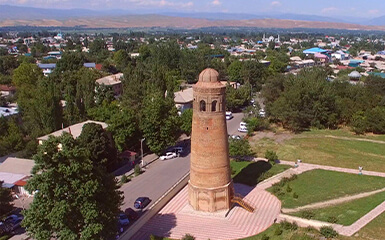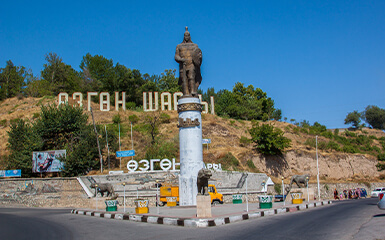Uzgen is a city located in the Osh region of the Central Asian Republic of Kyrgyzstan. The city has a population of about 50,000, the majority ethnic Uzbeks, and is the administrative centre of the Uzgen district of the same name.
Uzgen is located on the north coast of Karadarja, at the eastern end of the Fergana Valley, 55 km northeast of Osh and 30 km southeast of Jalalabad.
Uzgen has historical significance as one of the oldest cities in Kyrgyzstan. The origins of the city date back to the 2nd and 1st centuries BC. It was a trading post and customs post on a branch of the Silk Road that stretched from the Fergana Valley to Kashgar when the Karadarja valley narrowed. The place is mentioned in Chinese records from the 2nd century BC. It is said that the military camp of Alexander the Great was here before. During excavations, traces of pre-Christian city walls were found at this place.
Several well-preserved buildings in the Uzgen archaeology-architecture-museum complex, on a park-like open space close to the city centre and next to the administrative building of Uzgen district, date from the heyday of the Karakhanids in the 11th and 12th centuries. On the north side of the complex is a minaret, which is only 27.5 m high today and is probably a model for the minarets built by the Karakhanids in Bukhara and Vobkent. The upper part of the 8.5 m wide tapering tower, which was originally much higher, was destroyed in an earthquake in the 16th century. Today, a dome over a viewing platform crowns it.
About 150 m further southeast are the tombs of Uzgen, which at first glance appears to be a single building, with impressive wall decorations on the west-facing portal side and three tombs made of baked brick. They are among the few early Islamic structures that survived Genghis Khan's conquest of Transoxiana. The oldest and largest of the three is that of Arslan-Ilek Nasr-ben-Ali, the conqueror of Bukhara and Samarkand, in the middle. The 12 m high building has a square plan and its side length is approximately 11.5 m. Ornamental terracotta and carved alabaster with geometric and branch patterns adorn the front. The rectangular planned tomb of Jelaleddin el-Hussein, which was added to the north in 1152, is characterized by the surface decoration that adorns the entire façade. For whom the southern mausoleum, built in 1186, was no longer known; it is the smallest of the three, but is also the most ostentatiously decorated with ornaments, arabesques, and writing friezes.In 1881, a border station was first established by Russia and China at the Torugart Pass. In 1905, the British consul in Kashgar, George Macartney, determined that the Russians had built a 27-foot-wide road from the Kyrgyz side to the Torugart Pass and half a mile further into Chinese territory. In 1906, under Russian pressure, China allowed the road to be continued on Chinese territory. In 1952, the Torugart Pass replaced the border crossing at Erkeshtam, 165 km southwest, as the most important road connection between Xinjiang and the then Kyrgyz SSR. Some works by Chingiz Aytmatov give a literary impression of the circumstances of road construction and long-distance traffic at that time on this route.
Today, the Torugart Pass and Erkeshtam are the only cross-border routes between Kyrgyzstan and China. Until 2002, the Torugart was the only border crossing between the two countries that could be used by tourists.


